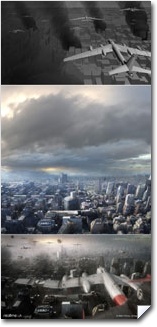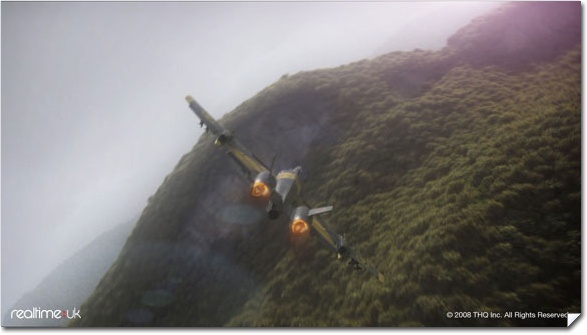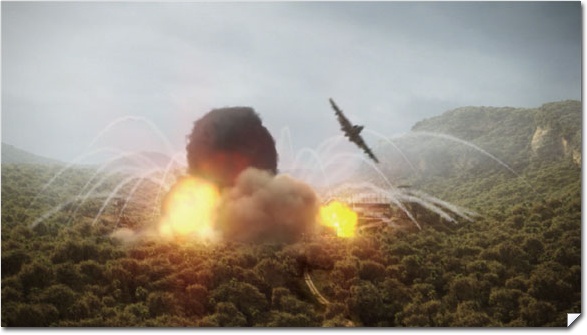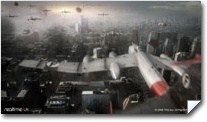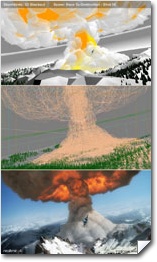Vue for THQ's Stormbirds Game Cinematic |
"I couldn’t imagine the movie without the use of Vue".
"Vue gave us the ability to create realistic and natural detail which we couldn’t have generated in any other way. "

Realtime:UK, a UK based animation studio, used Vue for several shots for the Cinematic of THQ's recently-canceled game , "Stormbirds".
We had the great privilege to talk with Ian Jones, Technical Director, and Peter Kolus, Digital Artist on the "Stormbirds" game cinematic:
About the Crew
E-on: Can you tell us a bit about yourself? What's your background experience in the CG industry?
Ian Jones: I’ve been with RealtimeUK for almost eight years and I’ve been Technical Director on many of RealtimeUK’s game cinematics such as SRS, MotorStorm 1 & 2, Juiced2 and Stormbirds. I also create the 3d blockouts at the beginning of a job as well as doing a lot of the special effects works like explosions.
Peter Kolus: I work at RealtimeUK as a Digital Artist. My main tasks are modeling and texturing but I also work on lighting and rendering on some projects. I started my career in 2005 at a small company in Poland where I come from. In 2007 I moved to UK where I now live and work.
How long have you been working on the StormBirds Cinematic? And what were the general guidelines you had to follow?
IJ: Stormbirds was a 3 month production for 8 artists. Our reference for cinematics tends to be game design documents, pre-viz & some game assets depending on how far along development is. On this occasion the client had an impressive body of concept art which was pretty inspiring and outlined ideas for missions & plane designs. It was our remit to digest all this information and create a cinematic version of the game with the emphasis being on cool camera work, exciting animation and awesome FX.
When did you see Vue for the first time? Is this the first project you’ve worked with Vue on?
IJ: We’re always on the look out for new tools to add into our workflow. Much of our current production pipeline was developed while working on a number of intro movies for Sony’s “Buzz” series. On both “Jungle Party” and “Buzz Hollywood” we used Vue on a small scale to create scenes and backgrounds. We were very happy with the results and could already see that is was a powerful tool.
Can you let us know what was the selection process for Vue for this project?
IJ: Working on Stormbirds, we quickly realized that we wouldn’t be able to achieve the complex jungle scene within 3dsMax.
PK: We’d recently created a forest in 3dsMax using Vray proxy objects, but this time we wanted to push things further both in terms of efficiency & creativity.
IJ: From our experience with the Buzz projects, we were confident that Vue could deliver.
PK: I knew Vue from some smaller personal projects and I was eager to work with it on this scale.
Technical Aspects
What’s Vue’s place in the production pipeline? Could you explain us the few steps that leads from the concept art to the final shot?
IJ: We used a rough 3d blockout to pin down the overall layout of the scene along with plane’s motion and camera moves. It was also important to establish the look and feel of the shots with our concept artist because it was very difficult to visualize such a complex and atmospheric shot with just the primitive geometry in out blockout.
IJ: One of our initial concerns was that the scene created in Vue would look different to the other scenes which were to be created in 3dsMax. So we created some of the scene assets within max. The jungle floor, cliff faces and the entire military campsite were modeled and texture within Max and then exported to Vue. We had a rather complex camera animation rig which allows us to recreate the look and feel of a physical camera. We baked the entire rig down to just the camera’s coordinates and brought that to Vue.
PK: We used the VueSync plugin for 3dsMax to export all camera animations. We populated the majority of the scene with an ecosystem and then manually placed some trees to fine tune the areas around the camp.
Most of the scenery for the other shots was done in Max, so what did Vue bring to your team for these specific shots?
IJ: Vue’s Ecosystem allowed us to control and tweak an entire scene with relative ease. It was also able to render anything we threw at it. Vue gave us the ability to create realistic and natural detail which we couldn’t have generated in any other way. I couldn’t imagine the movie having a jungle scene without the use of Vue.
How did you match the lighting between the rest of the cinematic shots and the scenes created in Vue?
IJ: This was never really going to be a problem. Luckily Stormbirds was made up of four very different environments. This meant that the lighting and overall look of the single Vue scene would never be directly comparable with other scenes created in Max. However, as many of the 3dsMax scenes used matte paintings to extend the 3d environments, we chose to do the same with Vue scene.
How did you create the atmosphere effects for the non-Vue shots?
IJ: Many of the 3dsMax environments made good use of matte paintings for skies and smoke. Any 3d volumes of clouds or smoke were created with a particle system and rendered with Sitni Sati’s Afterburn within Max.
Do you remember the quality settings you’ve used in Vue? How large did you render the animation?
PK: There is so many options to set-up when it comes to render animation in Vue that I can't remember them now… I spent a lot of time reading forums like CGsociety or e-on forum to help find the best settings. The key is to find a compromise between speed and quality, set-up good AA and don't get crazy when it comes to rendering the layers, you really don't need masks for all the leaves in the scene. The final render size was 1280x720.
How did you render everything, did you render the whole Vue animation and then composited with max animations afterwards?
IJ: The environments, including the imported floors and cliff faces, were rendered along with the trees in Vue using the render cow distribution rendering. We had a masked area around the military camp to allow us to composite in a Max render. We didn’t create motion blur within Vue as we couldn't generate velocity passes when rendering with the render cows. However, we were able to generate pixel velocity data from the original Max scene (without trees) and used it to apply motion blur to the Vue render in post. This had its advantages as it meant the entire scene had the same type of motion blur. This helped integrate the plane, explosions and campsite into the Vue render for the final composite.
I read that you have used some camera mapping techniques for the A10-like shot, can you tell us a bit more about this?
IJ: The shots where the A10 strafes the village were blocked out with buildings, vehicles and props in Max, they were then moved over to Vue to have the trees added. Still renders from Max and Vue were composited together in Photoshop and worked up into a layered digital matte. These mattes were then camera projected back onto the original Max scene and rendered from the scenes camera.
How did you add the explosion effects? I know that you’ve used AfterBurn to create them, but how did you match these with the Vue environments?
IJ: The Afterburn explosions had to be illuminated and rendered completely independent of the Vue trees and environment. The lighting was matched up by eye, using basic three-point lighting. Simple geometry was created and used in place of the Vue environment to receive shadows and mask out any trees which appear in front of the effect.
About Vue
Are there any features you wouldn't be without? (What's your favorite part of Vue?)
PK: Vue is the easiest way to create environments like rainforests. The best part of Vue is obviously the Ecosystem, because it’s easy to control, it allows you totally freedom with the creation process. I’m also impressed with options like layered ecosystem materials, wind generation and the shear amount of layers you can render.
Will you be switching sooner or later to Vue 7, and if yes, what do you expect from it?
PK: I'd really love to use Vue again, as it is nice piece of software. Especially now with it's full integration with 3ds max. Personally I would like to see it work with Vray as well. The main issue I noticed since Vue 5 is the small quantity of trees in the libraries, but I heard there are many more included in Vue 7.
Watch the Stormbirds Trailer!
-
Have you created an interesting project with the help of one of our products? Would you like to see your work showcased here, and benefit from e-on's exposure?
Get in touch with us! Contact press@e-onsoftware.com.
-


